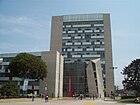File:El Sol de Perú, número 1 de 1822.pdf

Original file (4,339 × 6,614 pixels, file size: 3.01 MB, MIME type: application/pdf, 4 pages)
Captions
Captions
Summary[edit]
| DescriptionEl Sol de Perú, número 1 de 1822.pdf |
Español: Periódico de índole imperialista El Sol del Perú en su primer número. |
| Date | |
| Source | http://repositorio.pucp.edu.pe/index/bitstream/handle/123456789/49600/PER-PERU-0363-1.pdf |
| Author | Sociedad Patriótica de Lima |

|
This file is from the repository of Pontifical Catholic University of Peru, and is available online at repositorio.pucp.edu.pe/index/handle/123456789/49600. This tag does not indicate the copyright status of the attached work. A normal copyright tag is still required. See Commons:Licensing. English | español | македонски | +/− |

|
This image is in the public domain because it is a mere mechanical scan or photocopy of a public domain original, or – from the available evidence – is so similar to such a scan or photocopy that no copyright protection can be expected to arise. The original itself is in the public domain for the following reason:
This tag is designed for use where there may be a need to assert that any enhancements (eg brightness, contrast, colour-matching, sharpening) are in themselves insufficiently creative to generate a new copyright. It can be used where it is unknown whether any enhancements have been made, as well as when the enhancements are clear but insufficient. For known raw unenhanced scans you can use an appropriate {{PD-old}} tag instead. For usage, see Commons:When to use the PD-scan tag. |
| Public domainPublic domainfalsefalse |
This media file is in the public domain in the United States. This applies to U.S. works where the copyright has expired, often because its first publication occurred prior to January 1, 1929, and if not then due to lack of notice or renewal. See this page for further explanation.
|
||
This image might not be in the public domain outside of the United States; this especially applies in the countries and areas that do not apply the rule of the shorter term for US works, such as Canada, Mainland China (not Hong Kong or Macao), Germany, Mexico, and Switzerland. The creator and year of publication are essential information and must be provided. See Wikipedia:Public domain and Wikipedia:Copyrights for more details.
|
File history
Click on a date/time to view the file as it appeared at that time.
| Date/Time | Thumbnail | Dimensions | User | Comment | |
|---|---|---|---|---|---|
| current | 18:16, 25 July 2020 |  | 4,339 × 6,614, 4 pages (3.01 MB) | DSan (talk | contribs) | Transferred from http://repositorio.pucp.edu.pe/index/bitstream/handle/123456789/49600/PER-PERU-0363-1.pdf |
You cannot overwrite this file.
File usage on Commons
The following page uses this file:
- File:PER-PERU-0363-1.pdf (file redirect)
Metadata
This file contains additional information such as Exif metadata which may have been added by the digital camera, scanner, or software program used to create or digitize it. If the file has been modified from its original state, some details such as the timestamp may not fully reflect those of the original file. The timestamp is only as accurate as the clock in the camera, and it may be completely wrong.
| Short title | |
|---|---|
| Software used | Adobe Acrobat 11.0.7 |
| Conversion program | Adobe Acrobat 11.0.7 Image Conversion Plug-in |
| Encrypted | no |
| Page size | 2083 x 3175 pts |
| Version of PDF format | 1.6 |





